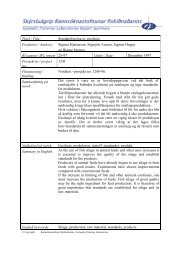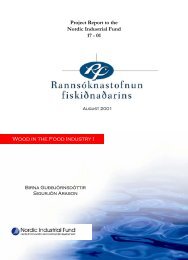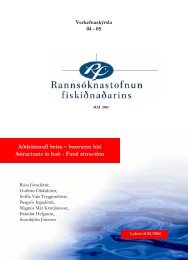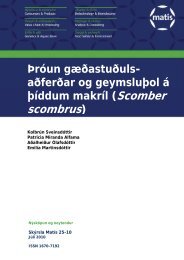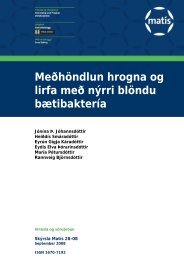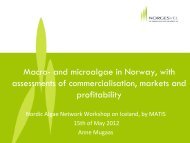Microbiology and Spoilage Trail in Nile Perch (Lates niloticus), Lake ...
Microbiology and Spoilage Trail in Nile Perch (Lates niloticus), Lake ...
Microbiology and Spoilage Trail in Nile Perch (Lates niloticus), Lake ...
Create successful ePaper yourself
Turn your PDF publications into a flip-book with our unique Google optimized e-Paper software.
cfu/g after 2-3 weeks storage <strong>in</strong> ice. In this study it has been noted that storage time up to 3<br />
weeks (17-22 days <strong>in</strong> ice), freshness quality of whole <strong>Nile</strong> perch can be accepted to process<br />
good quality products (chilled fillets). The storage life can be extended to 28-30 days for<br />
products that can be frozen or heat treated. At the end of storage time after 33 days the<br />
microbial loads rema<strong>in</strong>ed constant at ≥ 10 log10 cfu/g when the fish was judged spoiled.<br />
The bacterial load on sk<strong>in</strong> is usually lowered by wash<strong>in</strong>g fish (with treated water) dur<strong>in</strong>g<br />
process<strong>in</strong>g at establishments <strong>and</strong> by low temperature treatment like chill<strong>in</strong>g/super chill<strong>in</strong>g<br />
<strong>and</strong> freez<strong>in</strong>g of processed fillets/products. In this context it is important to note that<br />
microbial loads <strong>in</strong> freshly caught fish may range from hundreds to millions (10 2 -10 7 ) per<br />
square centimetres on sk<strong>in</strong> depend<strong>in</strong>g on species <strong>and</strong> or fish<strong>in</strong>g areas (Adams <strong>and</strong> Moss<br />
(2008); Shewan (1962); ICMSF (1980b); <strong>and</strong> Liston et al., 1976).<br />
5.2.1.3 Chemical analysis<br />
Total volatile base nitrogen changes dur<strong>in</strong>g storage of whole <strong>Nile</strong> perch <strong>in</strong> ice was<br />
characterized with a small marg<strong>in</strong> of 6-8mgN/100g of fish flesh <strong>in</strong> the first 3 weeks of<br />
storage <strong>in</strong> ice but then <strong>in</strong>creased to 17mgN/100g at the end of storage after 33 days. This<br />
<strong>in</strong>dicates that TVB-N is not a good <strong>in</strong>dicator for the changes <strong>in</strong> freshness quality of whole<br />
<strong>Nile</strong> perch as the QIM scores <strong>and</strong> spoilage micro flora counts. It was reported by Gram et<br />
al., (1989), that TVB-N <strong>in</strong> <strong>Nile</strong> perch which hardly reached ≥ 14-24mgN/100g. Similar low<br />
levels of TVB-N approximate 14-20mgN/100g were reported on whole un-gutted ra<strong>in</strong>bow<br />
trout fresh water fish (Chytiri et al., 2004) <strong>and</strong> on European sea bass (Decentrarchus<br />
labrax) by Castro et al., (2006). In accordance with ICMSF, (1980b) these levels are very<br />
low compared to other species which may have TVB-N <strong>in</strong> the range of 20-30mgN/100g<br />
dur<strong>in</strong>g the first 2 weeks <strong>and</strong> > 30mg/100g after 2 weeks of storage <strong>in</strong> ice. Other athours<br />
have reported TVB-N values between 25mgN/100g (Castro et al., 2006) <strong>and</strong> 30-<br />
35mgN/100g (Connel, 1995; Huss, 1988) <strong>in</strong> European sea bass <strong>and</strong> ra<strong>in</strong>bow trout (Gimenez<br />
et al., 2002) stored <strong>in</strong> ice. Thus <strong>in</strong> this study the TVB-N value <strong>in</strong> <strong>Nile</strong> perch was well below<br />
the maximum limits 30-35mgN/100g <strong>and</strong> 25mgN/100g mentioned before. A noticed<br />
change <strong>in</strong> TVB-N occurred when the SSOs counts reached > 9 log10 cfu/g which is <strong>in</strong><br />
agreement with observation made by Dalgaard et al., (1993), who reported that counts 10 8 -<br />
10 9 cfu/g of S. putrefaens (SSO) are required for production of TMA. The TMA is one of<br />
61




